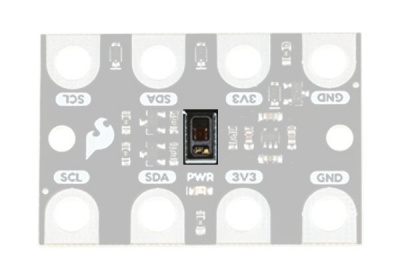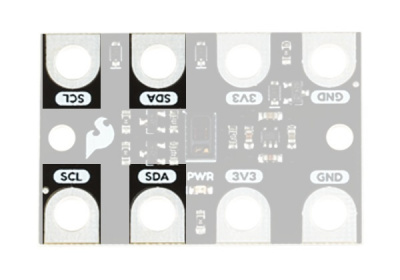SparkFun gator:particle Hookup Guide
Hardware Overview
The gator:particle consists of 4 pads for power and data.
| Contacts | Direction | Description |
|---|---|---|
| GND | N/A | Ground: Reference voltage and ground loop. |
| 3.3V | In | Power: Provides 3.3V to board. |
| SDA | Bi-directional | Data: Data and commands are transmitted between the sensor and microcontroller. |
| SCL | In | Clock: The microcontroller provides the timing needed to communicate on the data line. |
Power
The specified operating voltage for the MAX30102 is between 1.7V - 2V. For use with the gator:bit (v2) and micro:bit, you should provide 3.3V through the 3V3 and GND pads to keep the logic levels consistent; the 3.3V input is then regulated to 1.8V for the MAX30102.
MAX30102
The MAX30102 is a high-sensitivity pulse oximeter and heart-rate sensor that communicates over an I2C bus. The MAX30102 uses both red and IR LEDs along with a very sensitive photodetector for pulse oximetry (SpO2), heart-rate (HR) monitoring, and particle (PM) detection. For the most part, users will only need to know I2C addresses to prevent address conflicts with other devices or sensors.
Here are some of the characteristics of the MAX30102 sensor from the datasheet:
| Characteristic | Range |
|---|---|
| Operating Voltage | 1.8V to 2V |
| Supply Current |
Heart Rate and SpO2 Mode: 600 to 1200 µA IR Only Mode: 600 to 1200 µA |
| Operating Temperature | -40°C to 85°C |
| (ΣΔ) ADC |
Resolution: 15 to 18-bits (programmable) Sampling Rate: 50 - 3200 sps (programmable) |
| IR LED |
LED Wavelength: 870 to 900 nm (avg. 880 nm) Forward Voltage: 1.4V Radiant Power: 6.5 mW LED Driver Current: 0 to 50 mA (programmable) |
| Red LED |
LED Wavelength: 650 to 670 nm (avg. 660 nm) Forward Voltage: 2.1V Radiant Power: 9.8 mW LED Driver Current: 0 to 50 mA (programmable) |
| Photodetector |
Spectral Range of Sensitivity: 600 to 900 nm Radiant Sensitive Area: 1.36 mm2 |
| I2C Address |
0xAE - Write Address 0xAF - Read Address |
What are Heart-Rate and Oxygen Saturation?
Heart-rate is the speed at which your heart pumps blood through your body. Pulse oximetry is a noninvasive method of determining saturation of oxygen in your blood. However, this is a peripheral measurement is not always a direct reflection of the arterial oxygen saturation (SaO2), but two are correlated enough for clinical purposes. There are a multitude of applications for these measurements; especially, in the medical field.
Here are some examples of studies using HR monitoring and pulse oximetry:
- Accuracy of pulse oximeters in estimating heart rate at rest and during exercise
- Pulse oximetry: Understanding its basic principles facilitates appreciation of its limitations PDF Download
- Experiment: Exercise, Blood Pressure, and Oxygen Saturation Levels
Here are additional resources on how the MAX30102 functions for HR detection and pulse oximetry:
- AN6410: Signal to Noise Ratio (PDF)
- AN6433: Depth Penetration for Biosensors (PDF)
- Maxim: Open Source Heart Rate Algorithm (Arduino)
What are Particulates?
Particulate matter is the accumulation of matter (solid or liquid) in Earth's atmosphere. These particles vary in size, composition, and distribution. Their effects range from individual health on a microscopic scale to regional climate on a macroscopic scale. Particulate matter is also used in the food industry. Apiarist traditionally use bee smokers when harvesting honey. Smoking is also a method of flavoring and preserving meats and other products.
Here is a link to some experiments involving PM:
For more information on particulate matter and their detection, check out some of these resources:
- Particulate Matter (PM) Basics
- Optical Monitoring of Particulate Matter
- Maxim: Using Optical Sensors to Detect Particles
- Optical Particle Counters
- Smoke Detectors
I2C Connection
I2C is a communication protocol used to transfer data between controller and peripheral devices. It is a 2-wire connection consisting of SDA (data) and SCL (clock). The protocol is pretty well defined so it can be shared with multiple devices. This is beneficial for daisy chaining multiple devices together on a single bus. The primary thing users will need to watch out for is address conflicts (you can't have devices with the same address).


